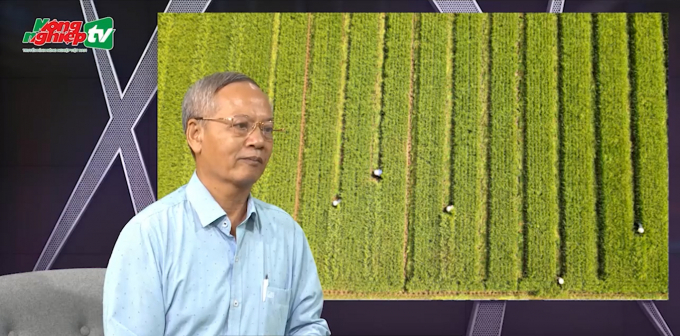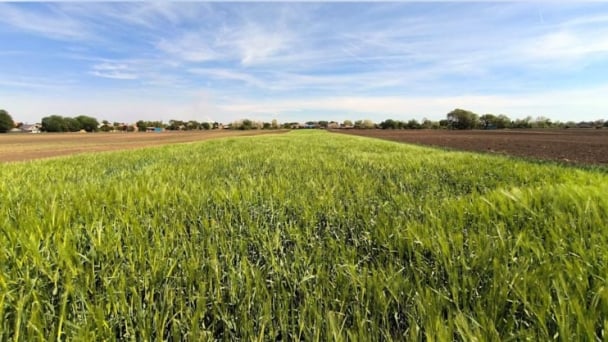June 19, 2025 | 10:01 GMT +7
June 19, 2025 | 10:01 GMT +7
Hotline: 0913.378.918
June 19, 2025 | 10:01 GMT +7
Hotline: 0913.378.918

Mr. Tran Xuan Dinh, Former Deputy Director of the Department of Crop Production.
In a recent interview with Vietnam Agriculture News, Mr. Tran Xuan Dinh, Former Deputy Director of the Department of Crop Production, shared his side of the story about the journey of hybrid rice in Vietnam.
When hybrid rice first entered Vietnam, I was working a local unit - the Agricultural Research Center of Thai Binh to be exact.
It’s common knowledge that there was a time when the relationship between Vietnam and China was quite “intense”, and so the border was closed. After our country’s implementation of renovation works and the occurrence of the Sichuan Conference, the relationship between Vietnam and China had been normalized. It was the start of strong exchanges at all levels, from central governments to mass organizations, particularly vibrant between the border people.
It was a period when we were suffering from the embargo, the economy was full of hardship, hunger and poverty, and we just got out of the bureaucracy subsidy system. The rice varieties then, as I remember back to the time I was at work in the province giving out instructions for production, were mostly long-duration varieties during the spring crop, for example the VN10 - a variety of Vietnam National University of Agriculture (previously the University of Agriculture I), or the M2 (Mexico 2) of the Field Crops Research Institute (FCRI).
In the next seasonal crops, several more varieties were released such as C70, C71 which were still belong to the medium-duration group, taking 160 - 170 days from sowing to harvest while the long-duration ones took 180 - 200 days. Later, we had some more varieties imported from the International Rice Research Institute (IRRI). They were NN22 and CR203 (or IR 8423) - the short-duration group.
Regarding hybrid rice’s entrance in Vietnam, the first path to mention was the people-to-people exchange in borderlands such as Quang Ninh, Lang Son, Cao Bang. Hybrid rice in China had grown quite prosperous at that time. As the relation between the two countries had been normalized which facilitated travel and trading, farmers were the first to receive those scientific advances. They bought the seeds from China, some were gifted and brought back to sow in terraces or fields laid in valleys and hillsides.
Those hybrid rice varieties were of top quality, which was a big surprise back then. The farmers planted them first, and news about them later reached the management teams, principally the provincial Departments of Agriculture. It was also to my knowledge that Quang Ninh brought this matter into view through the report in the Conference of Production organized by the Ministry of Agriculture.
After that, delegations and officers from the Ministry started conducting practical visits. The late Deputy Prime Minister Nguyen Cong Tan was a person full of passion for technological advances. He had also brought many technological innovations in crops, livestock, and forest varieties into Vietnam. It was thanks to “standard-bearers” that the entrance of hybrid rice could be realized and became an official program. That was how the era of hybrid rice started in Vietnam and created such wonder.
So when we came to see the things Quang Ninh had reported, it was clear that we were all in awe. It never crossed our mind that NN22 could be so incredible. NN22 grew up strong, the leaves came out beautifully. The plants bloomed firmly when ripen, gracefully stacked on top of each other.
Having witnessed such a hybrid rice field, from technical staff to leading cadres, all of the delegations were clearly astounded. After that, through the Ministry of Agriculture, following the instruction of the late Deputy Prime Minister Nguyen Cong Tan, the relationship between the two countries is increasingly strengthened especially in the agricultural sector.
The production of hybrid rice seeds was a very complicated technology. Back then, only China achieved success. While in the case of other countries, despite having an abundance of documents and scientific research works on hybrid rice genetics, since it was a self-pollinating plant with the male and female trait all within the rice flower, when the rice bloomed and the style lengthened, the plant had already self-pollinated.
The question was how to create heterosis. The rice plant must be sterile, meaning that the pollen must no longer be functional. That was the real important technology, and China had found it. Scholars in other countries such as the USA also researched this matter and had their own discoveries, but when the matter went down to replicating such technology to produce a large volume of hybrid seed, none other than China succeeded.
Translated by Samuel Pham
![Turning wind and rain into action: [9] Digitizing hydrometeorological data in response to climate change](https://t.ex-cdn.com/nongnghiepmoitruong.vn/608w/files/news/2025/06/17/z6704423696987_15fd32ffc26d590d204d520c9dac6786-nongnghiep-165943.jpg)
(VAN) Farmers have begun accessing hydrometeorological applications to adjust their cropping schedules, aiming to ensure productivity and adapt to climate change.
![Turning wind and rain into action: [8] Real-time salinity detection and early warning technology](https://t.ex-cdn.com/nongnghiepmoitruong.vn/608w/files/news/2025/06/17/z6704423696987_15fd32ffc26d590d204d520c9dac6786-nongnghiep-151127.jpg)
(VAN) Thanks to the integration of modern hydrological-hydraulic models, remote sensing technologies, and artificial intelligence, the accuracy of hydrological forecasting has significantly improved.
![Turning wind and rain into action: [7] Early disaster warnings help marine farmers minimize losses](https://t.ex-cdn.com/nongnghiepmoitruong.vn/608w/files/news/2025/06/17/z6704423696987_15fd32ffc26d590d204d520c9dac6786-nongnghiep-142942.jpg)
(VAN) In recent years, thanks to early disaster warnings and forecasting, marine farmers in Khanh Hoa province have been able to reduce risks and losses, thereby improving production efficiency.
![Turning wind and rain into action: [6] ‘Four on-the-spot’ disaster management software](https://t.ex-cdn.com/nongnghiepmoitruong.vn/608w/files/news/2025/06/17/e5a48259d6a262fc3bb3-nongnghiep-183800.jpg)
(VAN) By simply activating the scenario on the disaster management software, the relevant authorities immediately know how many households need to be evacuated, where to evacuate them to, and by what means of transportation…
![Turning wind and rain into action: [5] Hue applies modern technology in disaster forecasting](https://t.ex-cdn.com/nongnghiepmoitruong.vn/608w/files/news/2025/06/17/z6704423696987_15fd32ffc26d590d204d520c9dac6786-nongnghiep-093938.jpg)
(VAN) In Hue city, modern technology has recently been applied in meteorological and hydrological forecasting and warning, helping to reduce the damage caused by natural disasters.

(VAN) A cutting-edge farming technique being implemented on an experimental ranch in Arizona's Sonoran Desert has already saved a billion gallons of water over five years, according to Civil Eats.

(VAN) Poultry and pig production and the environment can be boosted through enhanced water technology, according to new research.